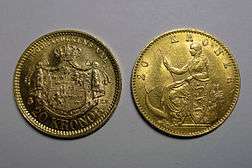Scandinavian Monetary Union
| Scandinavian Monetary Union | |
|---|---|
|
Two golden 20 kr coins, with identical weight and composition. The coin to the left is Swedish and the right one is Danish. | |
| Denominations | |
| Subunit | |
| 1⁄100 | øre/öre |
| Plural | kroner/krona |
| øre/öre | øre/öre (singular and plural) |
| Symbol | kr. |
| Coins |
1, 2, 5, 10, 25, 40, 50 øre 1, 2, 5, 10, 25 kroner |
| Demographics | |
| User(s) |
|
| Issuance | |
| Central bank | Danmarks Nationalbank, Skandinaviska Banken, Norges Bank, Swedish National Bank |
| Valuation | |
| Pegged with | Gold standard |
|
This infobox shows the latest status before this currency was rendered obsolete. | |
 |
| This article is part of a series on |
| Scandinavia |
|---|
| Geography |
| Viking Age |
| Political entities |
| Former political entities |
| History |
| Other topics |
| History of Scandinavia |
The Scandinavian Monetary Union (Danish: Den skandinaviske møntunion, Swedish: Skandinaviska myntunionen, Norwegian: Den skandinaviske myntunion) was a monetary union formed by Denmark and Sweden on 5 May 1873, by fixing their currencies against gold at par to each other. Norway, which was in union with Sweden, however with full inner autonomy, entered the union two years later, in 1875, by pegging its currency to gold at the same level as Denmark and Sweden, 2.48 kroner/kronor per gram of gold, or roughly 0.403 grams per krone/krona.[1] An equal valued krone/krona of the monetary union replaced the three legacy currencies at the rate of 1 krone/krona = 1⁄2 Danish rigsdaler = 1⁄4 Norwegian speciedaler = 1 Swedish riksdaler. The monetary union was one of the few tangible results of the Scandinavian political movement of the 19th century.
The union provided fixed exchange rates and stability in monetary terms, but the member countries continued to issue their own separate currencies. Although not initially foreseen, the perceived security led to a situation where the formally separate currencies were accepted on a basis of "as good as" the legal tender virtually throughout the entire area.
Upon acceding to the union, Sweden had the name of its currency changed from Riksdaler Riksmynt to Swedish krona. The word "krone/krona" literally means "crown", and the differences in spelling of the name represent the differences between the North Germanic languages.
The political union between Sweden and Norway was dissolved in 1905, but this did not affect the basis for co-operation in the monetary union. It was instead the outbreak of World War I in 1914 that brought an end to the monetary union. Sweden abandoned the tie to gold on 2 August 1914, and without a fixed exchange rate the free circulation came to an end.
All three countries still use the same currencies as during the monetary union, but they lost their peg, one to one, in 1914. The Icelandic króna is a derivative of the Danish krone, established after Iceland was elevated to a separate kingdom in union with Denmark in 1918. Iceland cut its ties to Denmark in 1944 and became a republic.
The Scandinavian Monetary Union was inspired by the Latin Monetary Union, established in 1865.[2]
See also
Economics
Banks
Currencies before the union
Currencies during and after the union
References
Further reading
- Henriksen, Ingrid, and Niels Kærgård. "The Scandinavian currency union 1875–1914." in Jaime Reis, ed., International Monetary Systems in Historical Perspective. (Palgrave Macmillan UK, 1995) pp. 91-112.
- Øksendal, Lars Fredrik. "The impact of the Scandinavian Monetary Union on financial market integration." Financial History Review 14#2 (2007): 125-148.

